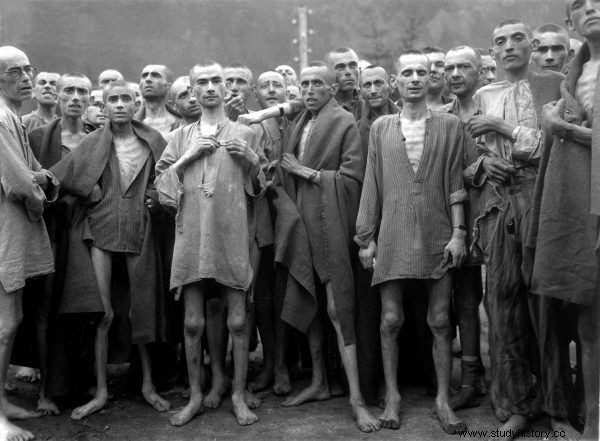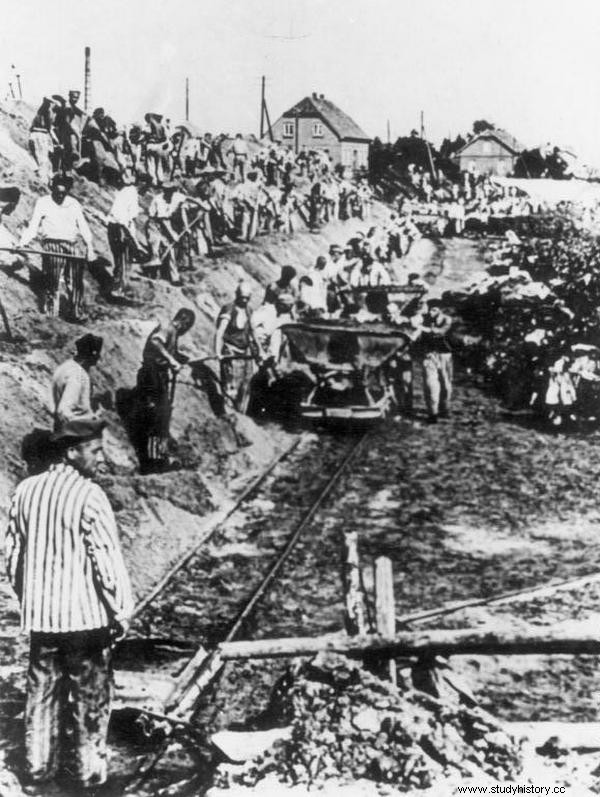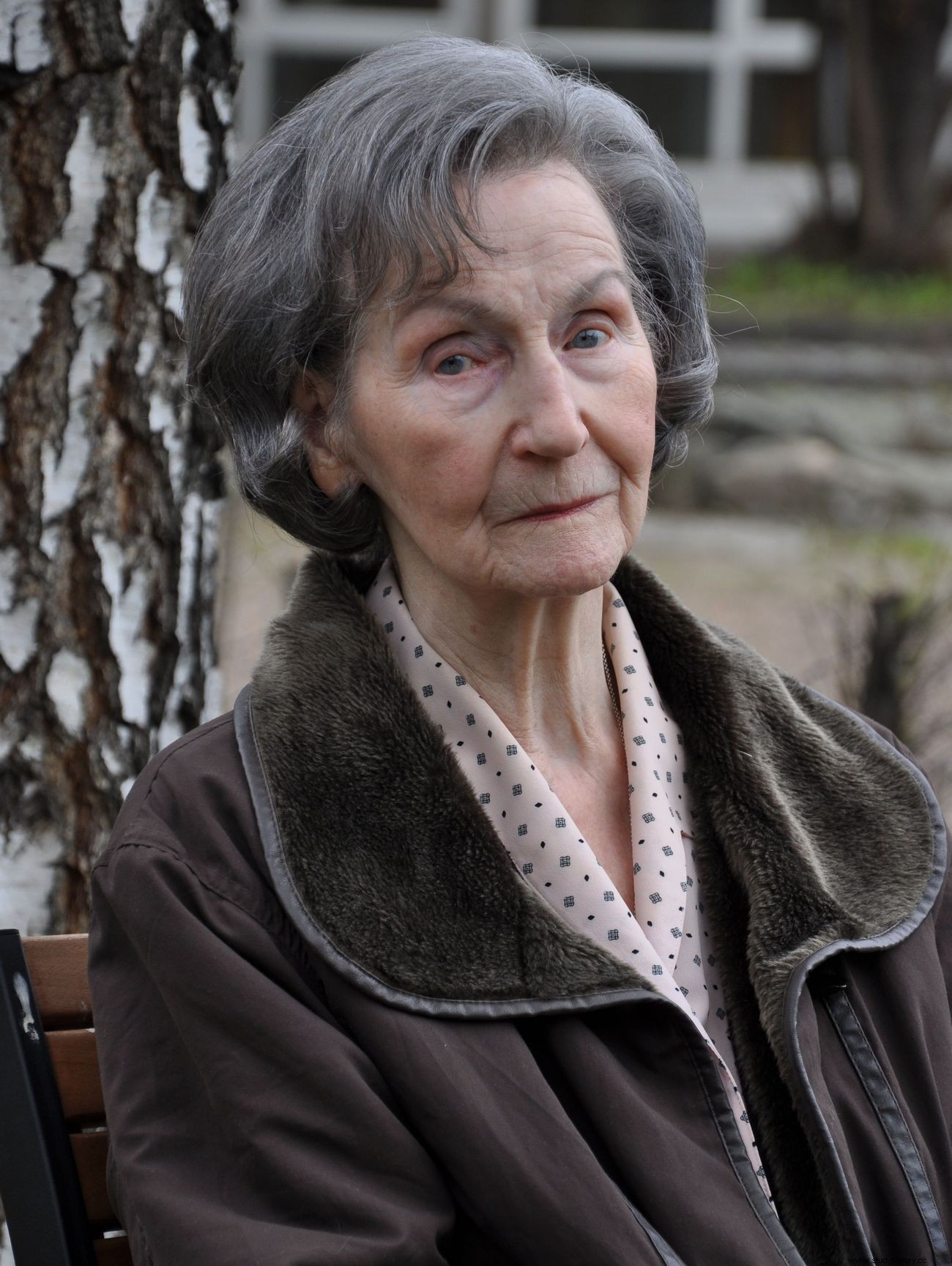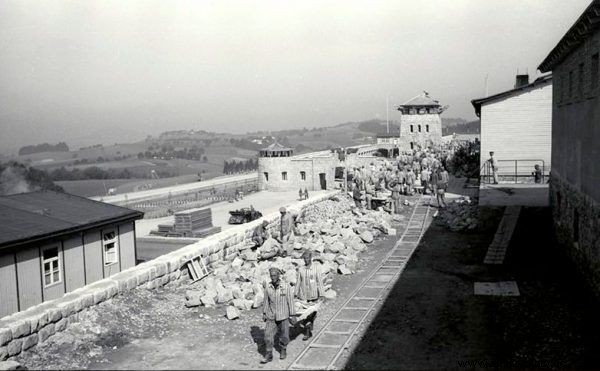Even though they were prisoners themselves, they even beat the SS men with their cunning and cruelty. They could abuse, rob and even kill other prisoners without consequences. How did they gain their position and what did they receive in return for loyal service to the Nazis?
"No, even the strongest, management of the camp would have been able to keep thousands of prisoners in their hands and lead them if they had not been helped by mutual antagonisms of prisoners," explained Rudolf Höss, the commander of Auschwitz after the war. It was true:no concentration camp could function if some prisoners did not cooperate with the Germans, controlling and intimidating their fellow inmates.
In Germany, even before the war, criminals and so-called "anti-social" prisoners were used to exercise control over other inmates in concentration camps. Usually they were murderers, thieves, pimps or prostitutes , previously serving sentences in prisons of the Reich.
In labor camps, as so-called function prisoners, they played many roles. First of all, they kept order and discipline, either in the entire closed area, or in individual rooms as block or room units. They also took part in the work of the camp office or acted as caretakers.
In return for their services, the functionaries received not only power, but also specific benefits, such as larger food rations, cigarettes and alcohol. They also usually lived in better conditions than the rest of the detainees, for example in a separate part of the building. Most importantly, however, they could use violence against those who were subject to them. They did it often, wanting to settle in the camp as comfortably as possible.

Kapos were the masters of the life and death of the prisoners they supervised. The photo shows the Ebensee survivors.
It is easy to guess that this privileged class was not popular among fellow prisoners. The most hated of them were the kapos, or overseers, who looked after the prisoners during forced labor.
Cruel commando overseers
"Kapo" is a word from the so-called lagerszprachy, or Lager language. We do not know the origin of this name. It is speculated, among other things, that it may be an abbreviation of Kameradenpolizei (which means "peer police") . Another theory is that it was borrowed from Italian where capo it means "head", but also "warden, boss". Interestingly, this term was not known everywhere. In some camps, the kapo was sometimes called a "capo", "capoman" or even - as in Dachau - "goat". The women performing this function were called, inter alia, "anwazerka" or "kapomanka".
The kapo could be identified by the yellow armband and the whipping stick. He had a working group under him, i.e. a commando, and usually had helpers. The latter were called variously:voraibeiterami, hilfskapo, unterkapo or kopapo. It happened that larger teams were established - then they were supervised by not one, but several superiors. They were all subordinated to the camp chief "oberkapo".
Prisoners-supervisors cooperating with the camp administration were responsible for creating and functioning of the commandos. They supervised discipline during work and took care to maintain the appropriate pace of work. They also had to prevent escapes and report the numbers of the supervised group. They had almost unlimited power over the other imprisoned. They could punish them in any way, receive food rations, beat them, and even kill them without risking any consequences . In fact, they often competed in cruelty. They provoked and tormented the inmates, if only to please their superiors
“He was giving irrevocable orders. Every day, to show off his vigilance and show off his power, he chose, for example, a chosen prisoner and hit him with blows ”- this is how Charles Liblau, a prisoner of KL Auschwitz, described Ignatz, one of his overseers. About another, he wrote that he was characterized by:
servility to new bosses [from the SS, fn. ed.]. The morbid pursuit of dominance and command was unleashed on prisoners who had the misfortune to fall under his orders. He tortured them and killed them .

Without the Capo's help, the Nazis would never have been able to make hundreds of thousands of concentration camp prisoners do slave labor.
Zofia Posmysz, a writer who was also imprisoned in the camp during the war, recalled her antiquities in turn as follows:“Once a prisoner was hit, she had to die in the end. Not immediately. Lora and Truda had already taken care of that. They did not forget the unfinished victim. ”
The position of the kapo was not, however, inviolable. If any of them did not perform well in their position, they could lose their function and join the rank and file of prisoners. He was then exposed to what others did:hard work, humiliation, beating, death from exhaustion or as a result of selection. Additionally, he was threatened with revenge from his former subordinates. This was enough for most of the hated overseers to be even more diligent in their duties.
Some people helped
During the war, the proportions between the different types of prisoners imprisoned in concentration camps gradually changed. Political prisoners and representatives of other nationalities than German, including Poles or Jews, began to join the functionaries. They were employed in the camp administration, they also became room staff or block supervisors. Others were assigned to the role of kapos.
These changes slightly influenced the rigor of the camp. It happened that the functional prisoners from the group of political prisoners used their position not only for their own purposes, but also to relieve the rest. When Zofia Posmysz came to Oświęcim in mid-1942, there was a Polish capo among the kapos who looked after her, who tried to help her subordinate prisoners as much as possible. She allowed short breaks during work and warned when SS overseers were approaching.

The story of Zofia Posmysz shows that not all kapos were degenerate sadists.
Kapo was also Stefan Krukowski, who "reached" this position at the end of his long stay in Mauthausen. He was "promoted" to the position of a camp promoter, an employee of the SS uniforms warehouse. Before that, he had gone through all the stages of life in the camp. He was in the penal company for a while, he was even a so-called Muslim , that is, a person extremely exhausted and unable to work, waiting to die. Years later, in the book I Was a Kapo, in which he described his experiences, he admitted that the transition to a higher caste of prisoners had psychological effects. As he himself mentioned:
This sudden metamorphosis amused me . Figured em si ę that even a person who is experienced to the point of cynicism also feels a certain happy from the sudden "immensity of power." Sometimes he caught em si on the fact that my pose ceases to be a role .
Krukowski used his privileged position not only to secure himself larger rations. He also helped others:
I really couldn't eat what was coming in, and I certainly didn't drink all that slivovitz. More than a few people lived from this "organization" ó b, w ó dka, given in time in the right hands, could save many lives. I was just an intermediary. At that time, certainly an intermediary who was not hungry and not cold.

Stefan Krukowski, after spending many years in Mauthausen, finally became a Kapo.
Unfortunately, such as Krukowski or the Polish woman remembered by Zofia Posmysz were only exceptions. Kapos have become a symbol of terror in German concentration camps. Thanks to their presence, the Nazis were able to save and reduce the SS personnel necessary to maintain the unit. And also to share with prisoners the responsibility for the violence in the camps.
After the war, some kapos were brought to trial either individually or together with their superiors from the SS. Some of them died at the hands of their former subordinates. However, the post-war fate of many cruel officials remains unknown.
Inspiration:
This article was inspired by the latest novel by Maciej Siembieda, entitled Place and Name , Capital Letter 2018.
